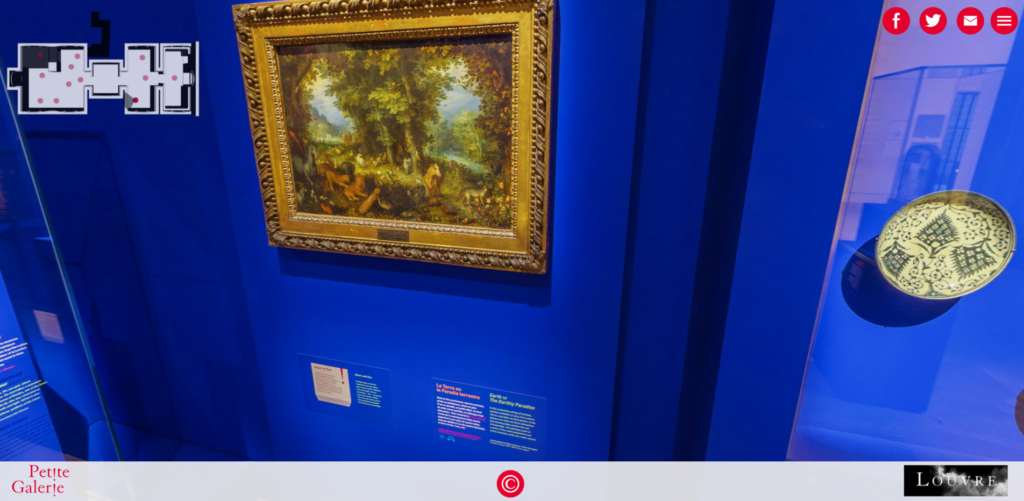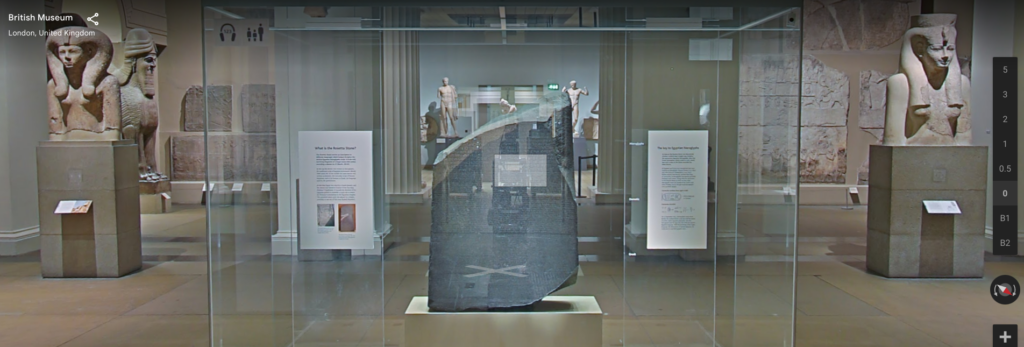For this post, I chose to highlight the differences and similarities in the Louvre Museum in Paris and the British Museum in London. The first online exhibit I explored was the Petite Galerie in the Louvre. The Louvre first set up 3D online exhibits during the Covid pandemic for school children and the online experience is set up so that a visitor literally tours the palace by clicking arrows to move around. The experience is similar to online house tours. In this way, a visitor can start anywhere in the museum they’d like, and then move around the halls and different exhibits. Overall, it’s a cool way to experience one of the highlights of Paris without having to spend thousands of dollars on airfare and hotels! And it’s very, very clear that multiple departments were involved in this online museum, from education to IT to the people setting up the cameras (which are also click-to-view, which is nice). However, I do tend to get a little frustrated at the quality of the point and click. The directions that the screen moves in relation to the mouse cursor takes some getting used to, and even then it’s still on the jerky side. The exhibits themselves, as in the artwork, is clear enough, but the descriptions are small and blurry, even when zooming in. So while you can see the artwork, you can’t really read anything about it. I will say though, it’s still a cool experience to “visit” the Louvre, and I cannot wait to visit in person!
The other online exhibition I chose is the Rosetta Stone from the British Museum in London, England. I chose this particular exhibit simply because I’ve seen it in person, and I wanted to see how the online experience compared to the real deal! No doubt about it, the real deal is always better, but I did enjoy seeing the Rosetta Stone again from the comfort of my own home. The detail is clear, which is great, because I can stare for hours at the Rosetta Stone. I just find it fascinating. The downside here is that the British Museum uses Google Maps’ Streetview, which is jerky and doesn’t let you see the descriptions of the exhibits, just like the Louvre. Well, one can see the description plaques, but again, the wording is really blurry, so you can’t decipher the writing! Also, the glare from the overhead lights on the glass is pretty terrible. Nonetheless, I spent forever on both sites. Despite their limitations, I really did love touring both of these really large, famous museums. I read somewhere years ago that both had opened up their online touring to allow for home learning during the Covid pandemic, and to allow schoolchildren to experience museums that they may not have had the opportunity to otherwise. I have no idea if that was true or not, but it seems like a great idea regardless!


REFERENCES:
The British Museum, London, England, United Kingdom. 2023. Accessed Apr 9, 2023.
The Louvre, Paris, France. 2023. Accessed April 9, 2023.
https://petitegalerie.louvre.fr/visite-virtuelle/saison1/#/petite_galerie_2/
Great post on the comparison of exhibits from the Louvre Museum and the the British Musem. I agree that the jerkiness of online museums can be frustrating and the quality of images presented within the online exhibit are sometimes not the best. I also find the idea of museums creating online exhibits for at-home-learning to be great and definitely effective in giving more accessible information to the general public.